| hypersonic landscapes | cz | en |
Field recordings from sites in urban landscape where sound at the upper limit of audibility1 is constantly present. Sound produced by various technical devices, sometimes unintentionally, sometimes intentionally as a method of modulation/conditioning of the environment as in the case of bird, rodent or teenager repellent. In both cases the sounds are at the edge of attention, ephemeral yet intense.
Prague, CRT monitor in Náměstí Republiky metro station, 17. 12. 2014
constant sound 15,65 kHz

Prague, fluorescent lamp in the newsstand near Hlavní nádraží, 27. 2. 2015
constant sound 14 kHz
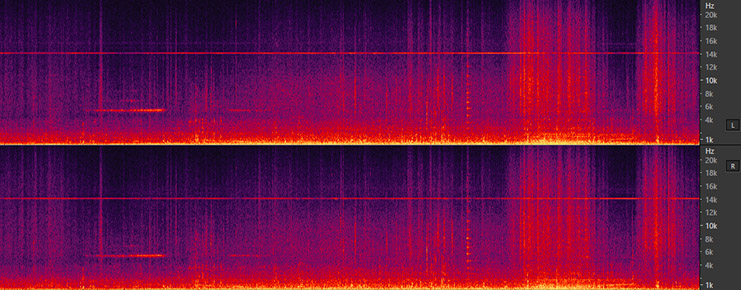
Prague, garden of private house, K Nové Vsi 16, Praha 13 - Jinonice, 10. 1. 2015
loud discontinuous sound irregularly fluctuating between 14,58 kHz a 18,8 kHz
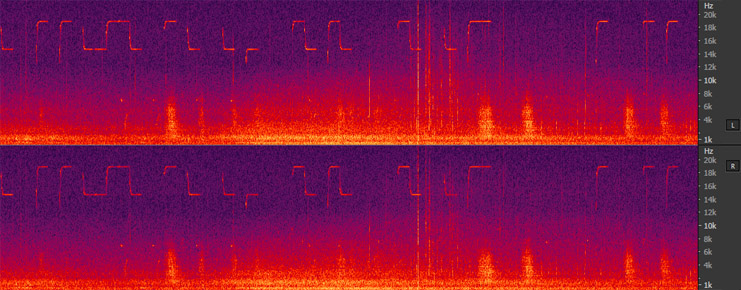
Prague, corridor in hotel Golf, Plzeňská 103/215c, Praha 5 - Motol, 15. 12. 2014
constant sound 19,75 kHz

Opava, Obecní dům, 21. 2. 2015
sound periodically pulsing between 13,2 kHz a 16,2 kHz
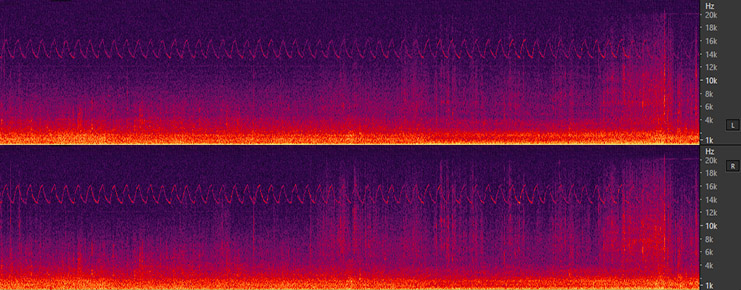
Opava, bird repeller on building of Slezské muzeum, 20. 2. 2015
discrete pulses of loud sound 25 kHz, at the end of the pulses up to 40 kHz + distinct harmonics 12.5 kHz and 6.4 kHz, at the end of each pulse approximately 14-18 kHz and 8 kHz
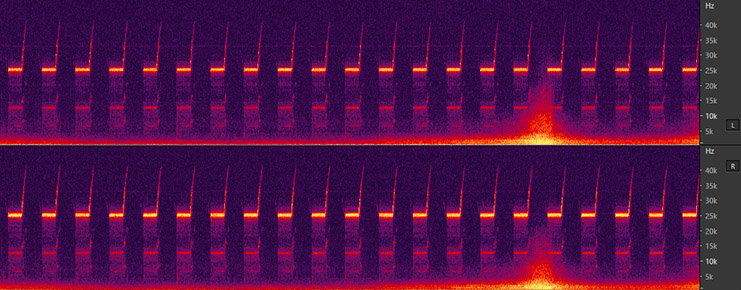
Opava, bird repeller on building of Slezské muzeum, from inside of the building, 20. 2. 2015
sound is noticeable even behind a closed window
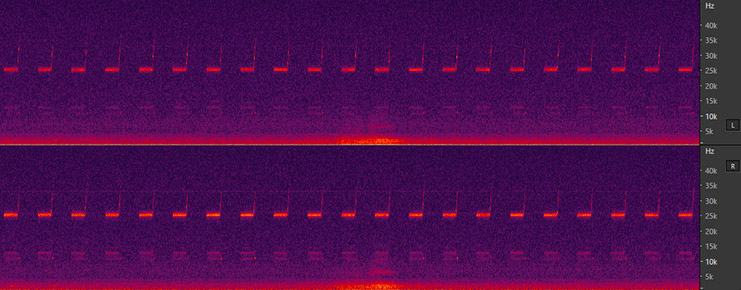
Berlin, Stresemannstraße 95, 16. 4. 2015
sound periodically pulsing between 14,2 kHz a 17,2 kHz
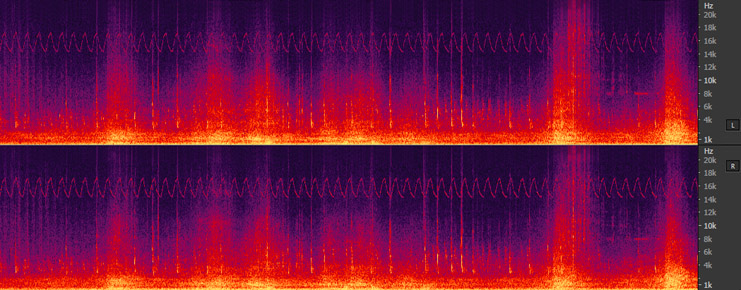
Berlin, passage at the Rathaus Steglitz bus station, 24. 4. 2015
rather quiet constant sound 15,7 kHz and 29,4 kHz
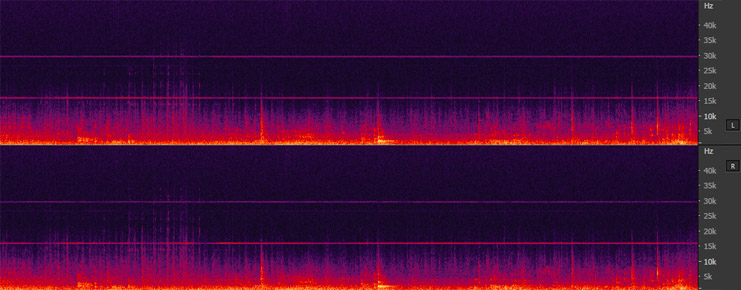
Prague, Bar Albertov, Na Slupi 3, Praha 2, 31. 5. 2015
loud discontinuous sound irregularly fluctuating between 16,2 kHz and 30,5 kHz + harmonics 32,4 - ca 40 kHz
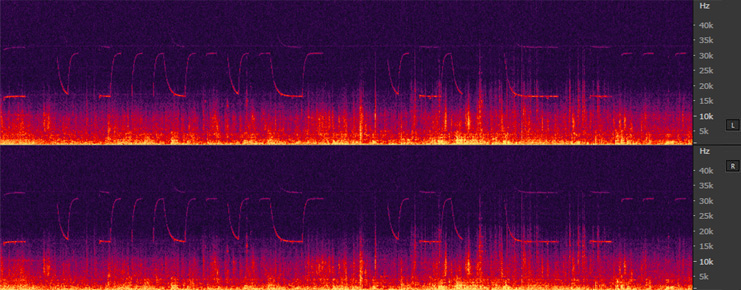
Paddock Wood, Kent, UK, 11 Church Road, 9. 10. 2015
probably rodent repellent, activates with movement detector, sound periodically pulsing between 24,5kHz and 34kHz and then between 17,8kHz and 25,8kHz + 35,4kHz and 44kHz
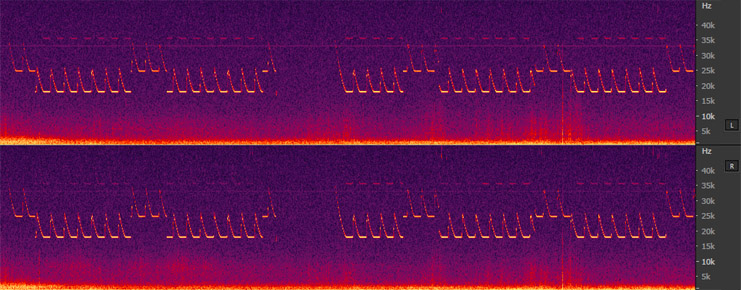
Prague, U Smaltovny 2, Praha 7 - Holešovice, 17. 1. 2016
sound periodically pulsing between 13,3 kHz a 16,6 kHz
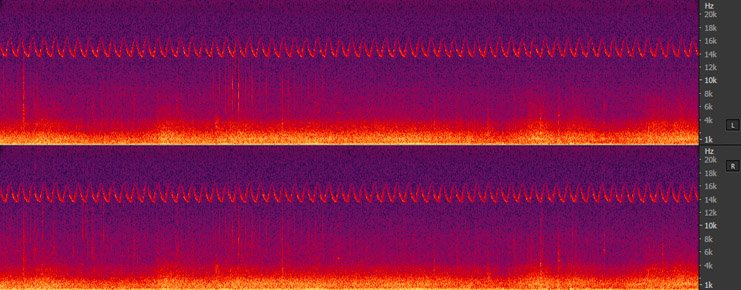
Prague, Hošťálkova 54, Praha 6 - Břevnov, 11. 6. 2016
repeating sequence between 10,7 kHz - 15,8 kHz and 18,7 kHz
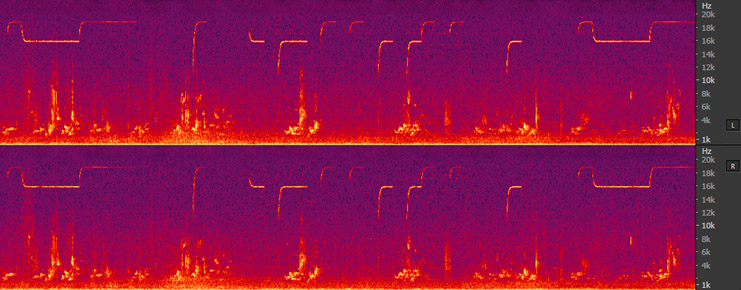
London, UK, on the corner of Whitcomb St. and Coventry St., 11. 6. 2016
frequencies between 14,9 kHz and 19,8 kHz alternating at regular interval
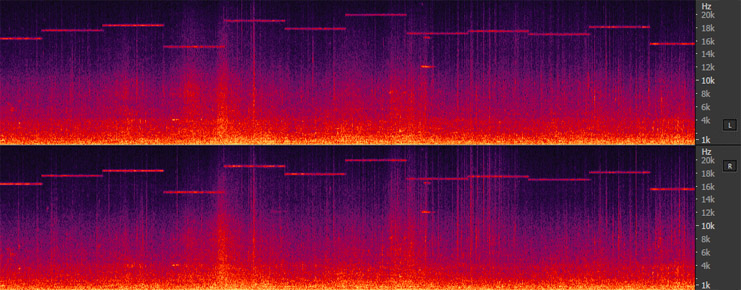
London, UK, on the corner of Whitcomb St. a Coventry St., 11. 6. 2016
in the middle of the junction (silence, shortly 19,6 kHz, then 16,6 kHz)
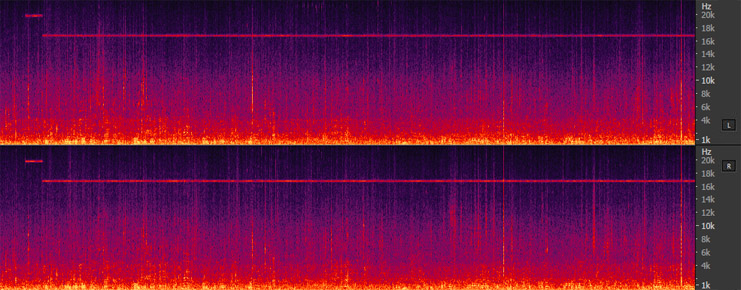
Prague, on the corner of Strahov stadium, Vaníčkova street, Praha 6 - Břevnov, 24. 1. 2017
periodically repeating sequence of unequally long pulses oscillating in the spectrum between 13,5 kHz - 24,5 kHz with dominant frequency around 22,8 kHz
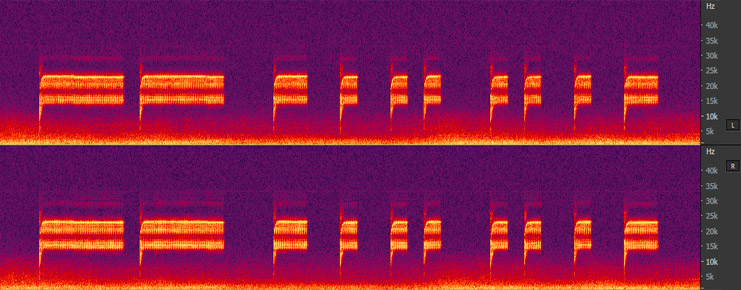
Prague, Lukavského 2, Praha 5 - Košíře, 13. 2. 2017
quiet sound oscillating around 15,1 kHz
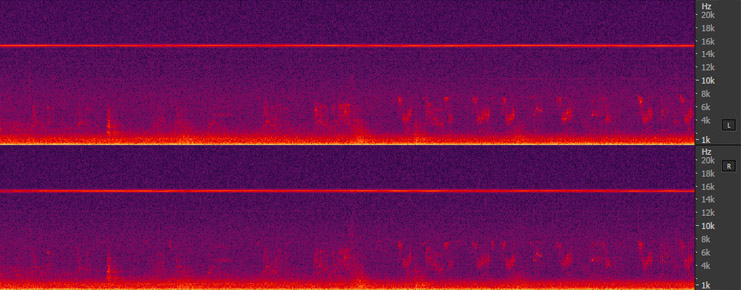
Únětice, Ke Splavu 175, 25. 2. 2017
two indipendent lines of the same shape, first one periodically pulsing between 12,1 kHz - 14,2 kHz, the second between 13,8 kHz - 16,1 kHz
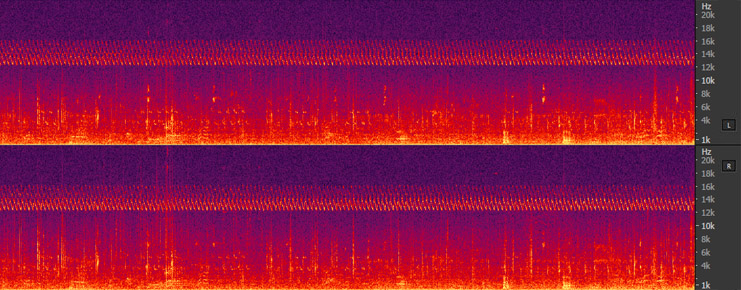
detail of the spectrum - 3 seconds from the beginning and the end of the recording
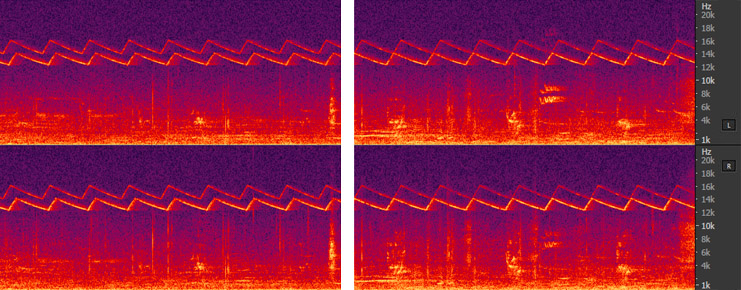
Prague, Patočkova 41, Praha 6 - Břevnov, 2. 3. 2017
quiet sound, periodic impulses 40 kHz - 9,8 kHz - 40 kHz
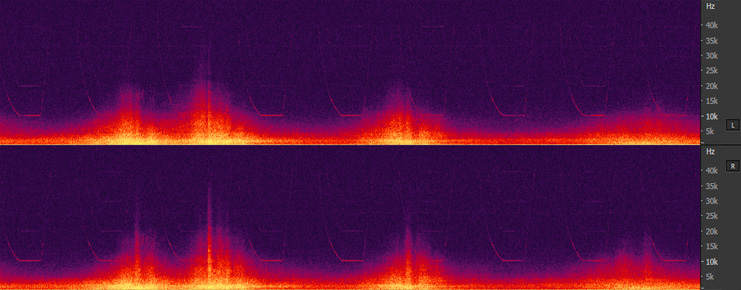
Český Krumlov, car with Hungarian number plate in front of the tennis court in Chvalšinská street, 26. 6. 2017
sound periodically oscillating between 13,7 kHz - 16,7 kHz
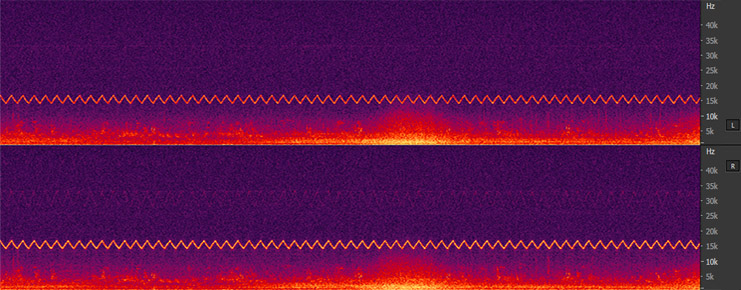
Prague, U Malvazinky 9, Praha 5 - Smíchov, 3. 2. 2018
quiet, periodically repeating sequence 12 kHz - 17 kHz + harmonics 34 kHz
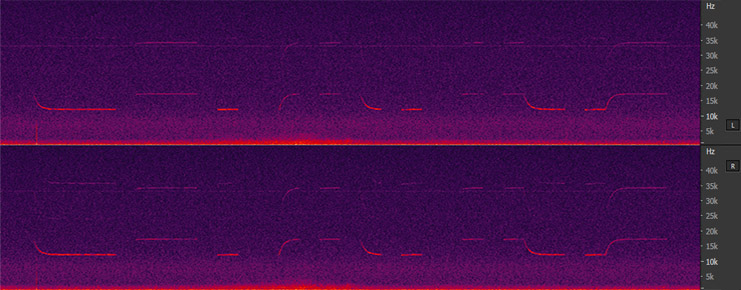
Paddock Wood, Kent, UK, St. Andrews Park, on toilets, 7. 10. 2018
16,1 kHz, loudnes is changig in regular pulses + harmonics 32,2 kHz
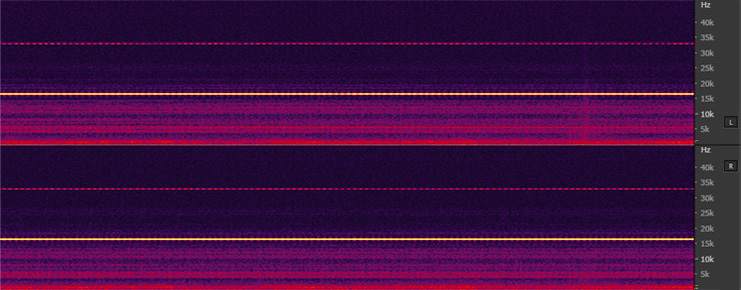
Prague, Punctum-Krásovka, in the kitchen, 27. 6. 2019
discontinuous sound irregularly fluctuating between 16,9 kHz and 28,2 kHz + 33 kHz - 45 kHz
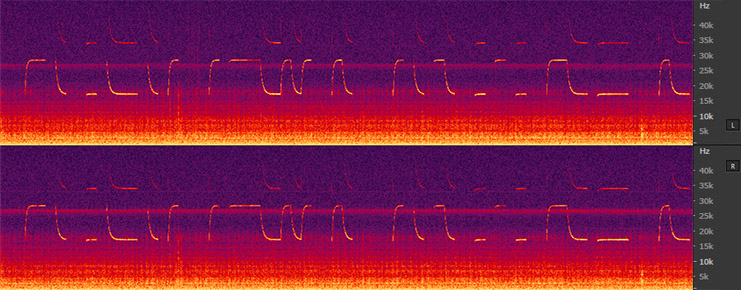
Send your own hypersonic places here: hypersoniclandscapes@gmail.com
↲ marek hlaváč
1 Humans can theoretically hear sound waves in the range of approximately 20 Hz - 20 kHz, but the upper limit is very individual for each person and decreases with age and exposure to noise (child can theoretically hear up to 24 kHz, for fifty years old is the limit aproximately 14 or 15 kHz). Even though hearing with ear is this limited, intensive higher frequencies (even higher than 20 kHz (ultrasonic), up to approximately 100 kHz) can be heard through bone conduction1.1.
According to some studies, humans can subconsciously perceive the inaudible sound waves just above the limit of audibility - Tsutomu Oohashi with his team named this phenomenon 'hypersonic efffect'. The result of their research1.2 suggests that frequencies above 20 kHz can subconsciously influence human brain and modulate perception of audible spectrum.1.3
With high intensity (over 120 dB) ultrasound near the limit of audibility (20-40 kHz) can cause physical conditions such as nausea, headache, tinnitus, ear pain, dizziness, fatigue and hearing damage upon prolonged exposure, at even higher intensity (over 150 db ) ultrasound causes heating and damage of tissue.1.4
Directionality of ultrasound is utilized for construction of directional speakers - the technology which uses nonlinear characteristic of air, that serves as demodulator of modulated ultrasound - the speaker emits a 'beam' of inaudible frequencies that becomes audible only for the person standing in front of it.1.5 Such technology thus offers completely new possibilities of spatiality of sound - sound is no longer immersive and all-pervading, but divided in space, designed only for someone.1.6
There is also speculation that ultrasound is used in sonic weapons that produce high-intensity directional sound (long-range acoustic device, LRAD), used eg. for crowd dispersal by army or police.1.7 The fact that perception of high frequencies deteriorates with increasing age is used to control the population by age - for example a product called 'mosquito' is intended to repel teenagers.1.8
On the other hand, in the realm of digital audio standards, compressed audio formats and Internet streaming services such as Vimeo or Soundcloud reigns policy of of high frequency filtering, not only of ultrasound but also of high frequencies of audible spectrum (from 16 kHz up).
From a futuristic view on high-frequency sound is interesting Steve Goodman's term 'unsound' - not yet audible - sound just outside the audible spectrum (infrasound and ultrasound) modulating affective perception. 'Unsound' may become, in its negative conotation, a means of control, but also a possibility of not yet audible in normal hearing range - new rhythms, resonance, texture and syntheses...1.9
1.1 http://publications.lib.chalmers.se/records/fulltext/147171.pdf;
http://www.tinnitus.vcu.edu/Pages/Ultrasonic%20Hearing.pdf
1.2 Tsutomu Oohashi at al.: Inaudible High Frequency Sounds Affect Brain Activity: Hypersonic Effect, in: Joournal of Neurology 83 (2000), 3548-3558; http://jn.physiology.org/content/83/6/3548.full
1.3 When testing subjects listened to sound containing audible and inaudible frequencies, change in their brain activity was observed, this change didn't occur when testing subjects listened to sound containing only audible spectrum.
1.4 see e.g.: http://www.hc-sc.gc.ca/ewh-semt/pubs/radiation/safety-code_24-securite/index-eng.php#a2.2.1;
http://www.hse.gov.uk/research/crr_pdf/2001/crr01343.pdf
1.5 e.g. Audio Spotlight (http://www.holosonics.com/), HyperSonic Sound by American Technology Corporation, company that supplies directional audio devices for US Army (http://www.lradx.com/site/) or Soundlazer (http://www.soundlazer.com/); more: http://en.wikipedia.org/wiki/Sound_from_ultrasound
1.6 Besides usage in advertisment or signaling, there are also rumors on the internet about allegations of use of these directional speakers for harassment - to make the victim feel insecure - the victim hears sound, e.g. voice, that nobody else hears.
(http://en.wikipedia.org/wiki/Sound_from_ultrasound#Organized_stalking)
1.7 http://en.wikipedia.org/wiki/Sonic_weapon; http://en.wikipedia.org/wiki/Sound_from_ultrasound#Military
1.8 http://movingsoundtech.com/
1.9 Steve Goodman: Sonic Warfare - Sound, Affect, and the Ecology of Fear, MIT Press 2010